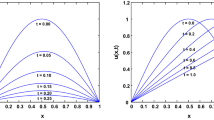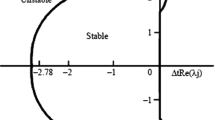Abstract
In this paper, the cubic–quintic complex Ginzburg–Landau (CQCGL) equation is numerically studied in 1D, 2D and 3D spaces. First, by the Strang splitting technique, the CQCGL equation is decomposed into three subproblems. After spatial discretization, the first and third problems lead to nonlinear ODEs that are solved by the Runge–Kutta technique. For the second problem, involving the spatial derivative, a fourth-order RBF—generated Hermite finite difference (RBF–HFD) method is used. The RBF–HFD scheme improves the accuracy in space direction compared with RBF-FD method, but temporal convergence order remains two due to the use of Strang splitting and Crank–Nicolson schemes in time direction. To improve the order of convergence in time direction, a temporal Richardson extrapolation technique is applied. Numerical results show that the order of convergence is improved from \(O({\tau ^2} + {h^4})\) to \(O({\tau ^4} + {h^4})\). Numerical tests are provided to confirm the accuracy and efficiency of the proposed method.



Similar content being viewed by others
Data Availability
This manuscript has no associated data.
References
Abbaszadeh M, Dehghan M (2020) Reduced order modeling of time-dependent incompressible Navier–Stokes equation with variable density based on a local radial basis functions-finite difference (LRBF-FD) technique and the POD/DEIM method. Comput Methods Appl Mech Eng 364:112914
Abbaszadeh M, Dehghan M (2020) Simulation flows with multiple phases and components via the radial basis functions-finite difference (RBF-FD) procedure: Shan–Chen model. Eng Anal Boundary Elem 119:151–161
Abbaszadeh M, Dehghan M (2022) The fourth-order time-discrete scheme and split-step direct meshless finite volume method for solving cubic-quintic complex Ginzburg–Landau equations on complicated geometries. Eng Comput 38:1543–1557
Bao W, Jaksch D (2003) An explicit unconditionally stable numerical method for solving damped nonlinear Schrödinger equations with a focusing nonlinearity. SIAM J Numer Anal 41(4):1406–1426
Bao W, Jin S, Markowich PA (2002) On time-splitting spectral approximations for the Schrödinger equation in the semiclassical regime. J Comput Phys 175(2):487–524
Crasovan L-C, Malomed B, Mihalache D (2000) Stable vortex solitons in the two-dimensional Ginzburg–Landau equation. Phys Rev E 63(1):016605
Degond P, Jin S, Tang M (2008) On the time splitting spectral method for the complex Ginzburg–Landau equation in the large time and space scale limit. SIAM J Sci Comput 30(5):2466–2487
Dehghan M (2006) Finite difference procedures for solving a problem arising in modeling and design of certain optoelectronic devices. Math Comput Simul 71(1):16–30
Dehghan M, Mohammadi V (2019) Two-dimensional simulation of the damped Kuramoto–Sivashinsky equation via radial basis function-generated finite difference scheme combined with an exponential time discretization. Eng Anal Bound Elem 107:168–184
Dehghan M, Taleei A (2010) A compact split-step finite difference method for solving the nonlinear Schrödinger equations with constant and variable coefficients. Comput Phys Commun 181(1):43–51
Haghi M, Mollapourasl R, Vanmaele M (2018) An RBF-FD method for pricing American options under jump-diffusion models. Comput Math Appl 76(10):2434–2459
Ilati M (2020) A meshless local moving Kriging method for solving Ginzburg–Landau equation on irregular domains. Eur Phys J Plus 135(11):1–18
Jiwari R, Kumar S, Mittal R, Awrejcewicz J (2020) A meshfree approach for analysis and computational modeling of non-linear Schrödinger equation. Comput Appl Math 39(2):1–25
Kadalbajoo MK, Kumar A, Tripathi LP (2018) Radial-basis-function-based finite difference operator splitting method for pricing American options. Int J Comput Math 95(11):2343–2359
Kansa EJ (1990) Multiquadrics—a scattered data approximation scheme with applications to computational fluid-dynamics-I surface approximations and partial derivative estimates. Comput Math Appl 19(8–9):127–145
Kumar A, Bhardwaj A (2020) A local meshless method for time fractional nonlinear diffusion wave equation. Numer Algorithms 85(4):1311–1334
Kumar A, Bhardwaj A, Kumar BR (2019) A meshless local collocation method for time fractional diffusion wave equation. Comput Math Appl 78(6):1851–1861
Kumar A, Bhardwaj A, Dubey S (2021) A local meshless method to approximate the time-fractional telegraph equation. Eng Comput 37(4):3473–3488
Larsson E, Lehto E, Heryudono A, Fornberg B (2013) Stable computation of differentiation matrices and scattered node stencils based on gaussian radial basis functions. SIAM J Sci Comput 35(4):A2096–A2119
Lehto E, Shankar V, Wright GB (2017) A radial basis function (RBF) compact finite difference (FD) scheme for reaction-diffusion equations on surfaces. SIAM J Sci Comput 39(5):A2129–A2151
Li H, Mollapourasl R, Haghi M (2019) A local radial basis function method for pricing options under the regime switching model. J Sci Comput 79(1):517–541
Mohammadi V, Dehghan M, De Marchi S (2021) Numerical simulation of a prostate tumor growth model by the RBF-FD scheme and a semi-implicit time discretization. J Comput Appl Math 388:113314
Mollapourasl R, Haghi M, Liu R (2018) Localized kernel-based approximation for pricing financial options under regime switching jump diffusion model. Appl Numer Math 134:81–104
Mollapourasl R, Haghi M, Heryudono A (2020) Numerical simulation and applications of the convection-diffusion-reaction equation with the radial basis function in a finite-difference mode. J Comput Finance 23(5):33–73
Narcowich FJ, Ward JD (1994) Generalized Hermite interpolation via matrix-valued conditionally positive definite functions. Math Comput 63(208):661–687
Narimani N, Dehghan M (2022) A direct RBF-PU method for simulating the infiltration of cytotoxic T-lymphocytes into the tumor microenvironment. Commun Nonlinear Sci Numer Simul 114:106616
Oruç Ö (2021) A local radial basis function-finite difference (RBF-FD) method for solving 1D and 2D coupled Schrödinger–Boussinesq (SBq) equations. Eng Anal Bound Elem 129:55–66
Oruç Ö (2022) A strong-form local meshless approach based on radial basis function-finite difference (RBF-FD) method for solving multi-dimensional coupled damped Schrödinger system appearing in Bose–Einstein condensates. Commun Nonlinear Sci Numer Simul 104:106042
Shcherbakov V (2016) Radial basis function partition of unity operator splitting method for pricing multi-asset American options. BIT Numer Math 56(4):1401–1423
Shokri A, Bahmani E (2019) Direct meshless local Petrov–Galerkin (DMLPG) method for 2D complex Ginzburg–Landau equation. Eng Anal Bound Elem 100:195–203
Shokri A, Dehghan M (2012) A meshless method using radial basis functions for the numerical solution of two-dimensional complex Ginzburg–Landau equation. Comput Model Eng Sci 84(4):333–358
Soleymani F, Akgül A (2019) Improved numerical solution of multi-asset option pricing problem: a localized RBF-FD approach. Chaos Solitons Fractals 119:298–309
Soleymani F, Zhu S (2021) On a high-order Gaussian radial basis function generated Hermite finite difference method and its application. Calcolo 58(4):1–22
Strang G (1968) On the construction and comparison of difference schemes. SIAM J Numer Anal 5(3):506–517
Wang H (2005) Numerical studies on the split-step finite difference method for nonlinear Schrödinger equations. Appl Math Comput 170(1):17–35
Wang H (2010) An efficient Chebyshev–Tau spectral method for Ginzburg–Landau–Schrödinger equations. Comput Phys Commun 181(2):325–340
Wang S, Zhang L (2013) An efficient split-step compact finite difference method for cubic-quintic complex Ginzburg–Landau equations. Comput Phys Commun 184(6):1511–1521
Wendland H (2004) Scattered data approximation, vol 17. Cambridge University Press, Cambridge
Yang Y, Soleymani F, Barfeie M, Tohidi E (2020) A radial basis function-Hermite finite difference approach to tackle cash-or-nothing and asset-or-nothing options. J Comput Appl Math 368:112523
Yu S, Zhao S, Wei G (2005) Local spectral time splitting method for first-and second-order partial differential equations. J Comput Phys 206(2):727–780
Zongmin W (1992) Hermite–Birkhoff interpolation of scattered data by radial basis functions. Approx Theory Appl 8(2):1–10
Acknowledgements
The authors thank the reviewers for their useful comments and suggestions that improved the paper.
Author information
Authors and Affiliations
Corresponding author
Ethics declarations
Conflict of interest
This work does not have any conflicts of interest.
Additional information
Communicated by Justin Wan.
Publisher's Note
Springer Nature remains neutral with regard to jurisdictional claims in published maps and institutional affiliations.
Rights and permissions
Springer Nature or its licensor (e.g. a society or other partner) holds exclusive rights to this article under a publishing agreement with the author(s) or other rightsholder(s); author self-archiving of the accepted manuscript version of this article is solely governed by the terms of such publishing agreement and applicable law.
About this article
Cite this article
Haghi, M., Ilati, M. & Dehghan, M. A radial basis function-Hermite finite difference (RBF-HFD) method for the cubic-quintic complex Ginzburg–Landau equation. Comp. Appl. Math. 42, 115 (2023). https://doi.org/10.1007/s40314-023-02256-3
Received:
Revised:
Accepted:
Published:
DOI: https://doi.org/10.1007/s40314-023-02256-3
Keywords
- RBF-generated Hermite finite difference method
- Cubic-quintic complex Ginzburg–Landau equation
- Strang splitting scheme
- Richardson extrapolation
- Nonlinear optics
- Bose–Einstein condensation.




